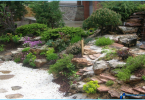The contents
The landscape design has been recognized and spread in the late twentieth century, especially in the densely populated countries of Western Europe, where there are very few wilderness areas. Landscape design includes the design and landscaping of land surrounding modern buildings, the creation of decorative water elements (fountains, artificial lakes, streams), the creation of ensembles of planted plants (flower beds, paths, ridges) etc.
To transform landscape design modern country and personal plots there are a lot of techniques. This landscaping, and the creation of artificial lakes, spectacular lighting areas, making landscape design a variety of decorative elements (benches, pavilions, bridges, a variety of decorative figures, landscape lighting, etc.). All this allows you to create individual and unique area for walks and recreation on the territory of your cottage or country home.

There are a lot of suggestions from the masters on gardening land plots, creation of original landscape design but if you have free time and desire to elevate your site yourself, you can test your hand at creating simple elements of landscape design, for example, to make a dry Creek in the country.

Dry Creek, in contrast to these bodies of water (pools, lakes, streams), is an imitation of the seabed and riverbed. This element of landscape design came to us from the Japanese Islands. The Japanese pay respect to the water element which is associated with the purity of life and the transience of time. In Japanese traditions, this element of landscape design is very popular, especially in those areas where it is impossible to recreate the real water composition. Dry brook is associated with the water element, giving the impression that the water source has dried up only recently, and the first rain will revive the thread and fill it again. No wonder dry Creek in the landscape design takes its rightful place. There are many design options for how to make a dry Creek in the country.
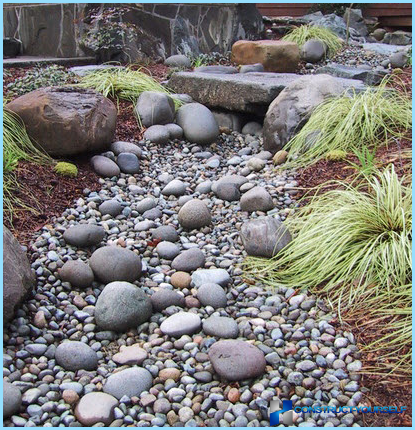
Strengths dry Creek:
- Savings relative cheapness of operation and the ability to make the riverbed dry trickle with his hands, not with the help of expensive masters of landscape design;
- The minimum time for building (to carry out major works for 2-3 days);
- Simple care in the future, unlike the present reservoir. It is necessary to destroy weeds and to follow the support shape of the channel;
- The ability to use for the design and execution of any plants, not necessarily hydrophilic, as in the case of a natural reservoir;
- Complete safety for children. In addition, the lack of mosquitoes, which love to live in places with high humidity.
How to choose the form of the dry Creek ↑
Choosing the shape of the channel of the future dry Creek, certainly consider the terrain. The source needs to be on a hill, the channel, as in the genuine version, should be top-down, sometimes tapering, sometimes extending.
The meandering form of the channel visually expands the space, the area will seem much bigger than in reality.
You can think through the location from which the flow originates, for example, the well of stones on a hill, or cleft in the rock, from which it can stream. At the source well will look tilted pitcher from which flows like water, as if it originates your dry Creek.

An interesting variant of landscape design can turn out if to figure out which flows into the Creek. It could be the bushes in the end of the section behind which it is impossible to trace the further movement of the water, a fence or any decorative structure. Most importantly, make your landscape design look natural, like a natural formation. You can also use branching channel, the merger of the sleeves and other options.

Looks very nice combination of dry Creek and wooden bridge in a landscape design. As additional decorative elements of landscape design used garden sculpture, wood fungi, masonry and other.

Materials for the floodplain and the bottom of dry Creek ↑
To fill the dry Creek channel will need to large boulders, cobbles, and gravel. A beautiful combination of colors and textures of the stone of the riverbed will allow you to create unique compositions that complement any landscape design plan.

It is advisable to use in your design the local options of stones to the brook is in complete harmony with the environment. Large stones are usually spread along the banks, and the channel is filled with small pebbles. To create the effect of the flow using flat stones.
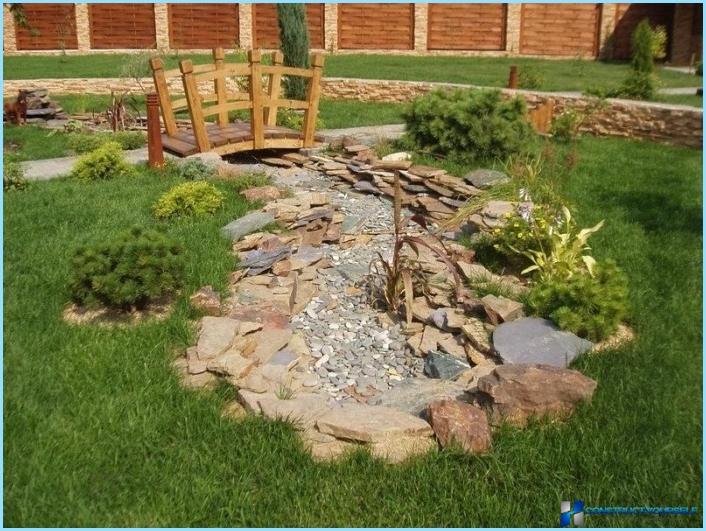
To give a naturalness to the landscape solution you can do a stream with gray-blue shades, if you use basalt, shale. The waters from granite, limestone and marble are red-brown shades. If desired, the design of stones can be enhanced with waterproof paint or varnish, shimmering in the sun, they will create the illusion of the current source.
The sequence of operations when creating a dry Creek ↑
Having defined the landscape design of the future dry Creek, it is necessary to mark the direction on the plot. You can do it with sand, or stretch a rope along the proposed stream. Working with the sand, the composition looks natural, is easy to correct by setting out a different path. The next step is the construction of.

Along the course of the future of the Creek to dig a small pit, the ratio of the width and depth of the channel should be approximately 2:1. If you have the width of the stream in some places is 1m, the depth of the pit in this place should be 0.5 m. the Surface of the pit is leveled with a rake.

On the bottom you need to put any kind of coating, such as a geotextile which allows water to enter and air to stream in the future from growing weeds. You can also concreted the bottom, use plastic sheeting or tar paper. If you are concerned that water will eventually erode your stone direction, it is possible the bottom layer of stones embedded in the riverbed, and the top to add more rocks to hide the bottom.

Then, on the surface, you can lay out the stones, ranging from the coast. Large boulders are placed along the edges, alternating with small pebbles. To simulate waterfalls and rapids used the most vivid and bright stones. On the bottom of the riverbed can also put glass pebbles, which will simulate water.

Flat stones – Lastouski put on an edge, create a simulation of water movement. The same effect can be obtained by using stones of blue shades. If in the middle of “water” channel to put a boulder with a pebble you can create around him an illusion of “whirlpool.” Importantly, the composition of the stones look natural.
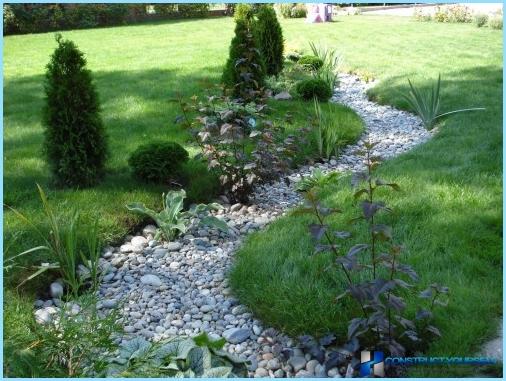
A good addition to the dry Creek is the bridge. If your site has a large solid stone, you can lay it across the Creek to “water” as it ran under him. If you have the desire and the material can do an imitation of the bridge of wood, with their own hands. The wooden bridge and dry Creek in the landscape design would be great to combine.

The next step of creating a dry Creek is decorating the shores of the plants. When choosing you must consider the climate of your region, as well as the composition of the soil on the site, availability of sunlight, humidity and temperature.
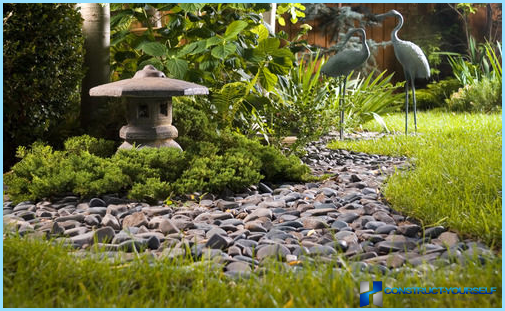
Of flowering plants, preference should be given to species with blue, light blue, purple flowers. You can also plant perennials such as Lobelia, primrose, periwinkle, silver Lily of the valley etc. look Good plants that naturally grow along the banks of reservoirs: sedge, calamus ordinary blue Bunting, Liliaceae grasses. The decoration of the streams will be tulips, daffodils, hyacinths, lilies.

To add individuality to the landscape design, landed at the rocky banks of dry Creek conifers – dwarf types of junipers, firs, pines. For them, well suited if light sandy loamy soil.

Planting shrubs with small leaves should be approached with caution, as during the autumn leaf fall will have to choose from your stream fallen leaves stuck among the stones. If harvesting the leaves you have purchased a leaf blower, you can safely land near the dry Creek bushes of dogwood and barberry, beautiful landscape because of the changing colors of the leaves of these wonderful shrubs will be provided to you all year round.

Care for dry Creek ↑
Care for dry Creek does not usually present any particular difficulty. It will be necessary periodically to pull weeds, removing weeds, watering plants. Remember that under the stones like to settle the ants, they also have to regularly get rid of to your dry stream, over time turned into an anthill.

But, in addition to its decorative features, dry stream and also performs the important tasks of landscape design:
- Serves as a drainage system that provides drain rain and flood water from your site;
- Moisture under stones, saving you time and reducing the frequency of watering of plants planted;
- Visually divides the plot, allowing you to highlight separate areas of landscape design;
- Helps to reduce soil erosion;
- Visually expanding the territory of your garden.

The calculation of the pebbles to create a dry Creek in the landscape design ↑
To calculate the approximate amount of pebble required for the arrangement of a dry Creek, you must take several measurements. Once you have decided on the future trajectory of the channel of the stream and using sand noted it on the site, using tape measure, measuring tape or rope measure the length of the stream in meters. Then indicate the average value of the channel width (about 50-80 cm), move to meters (0,5-0,8 m). The thickness of the layer of pebbles your future riverbed will be approximately 5 to 8 cm of 0.05-0.08 m. Now we need to multiply the values obtained.
For example, the length of the stream is assumed 25m, then the volume of the required number of pebbles is equal to:
Pebbles volume = length * thickness * average width of the channel;
25 m * 0.08 m * 0.8 m = 1.6 m cube.
If you plan to use additional branches to highlight the source or the mouth, you should consider this, buying the materials to create a dry Creek.


